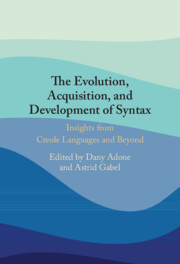Book contents
- The Evolution, Acquisition, and Development of Syntax
- The Evolution, Acquisition, and Development of Syntax
- Copyright page
- Contents
- Figures
- Tables
- Contributors
- Acknowledgments
- Abbreviations
- 1 Introduction
- Part I The Evolution of Syntax
- Part II The Acquisition of Syntax
- Part III The Development of Syntax
- 11 A Matter of Degree: All Languages are Mixed
- 12 Negative Concord in Creole Languages: Commonality and Variation in the Perspective of Bickerton’s Legacy
- 13 Contrasting the NPs of Indian Ocean French Creoles
- 14 The Nature and Development of the “Quacking Duck”
- 15 Beyond Creole: Reflexive Constructions in Cape Verdean Portuguese
- 16 Decreolization: A Special Case of Language Change?
- Index
- References
16 - Decreolization: A Special Case of Language Change?
from Part III - The Development of Syntax
Published online by Cambridge University Press: 19 February 2025
- The Evolution, Acquisition, and Development of Syntax
- The Evolution, Acquisition, and Development of Syntax
- Copyright page
- Contents
- Figures
- Tables
- Contributors
- Acknowledgments
- Abbreviations
- 1 Introduction
- Part I The Evolution of Syntax
- Part II The Acquisition of Syntax
- Part III The Development of Syntax
- 11 A Matter of Degree: All Languages are Mixed
- 12 Negative Concord in Creole Languages: Commonality and Variation in the Perspective of Bickerton’s Legacy
- 13 Contrasting the NPs of Indian Ocean French Creoles
- 14 The Nature and Development of the “Quacking Duck”
- 15 Beyond Creole: Reflexive Constructions in Cape Verdean Portuguese
- 16 Decreolization: A Special Case of Language Change?
- Index
- References
Summary
Mayeux’s chapter offers a new perspective on the notion of decreolisation which is also a possible path in the life cycle of a Creole language. Creoles in contact with their lexifiers are famously supposed to undergo decreolisation, a process Bickerton termed a “special case” (1980: 113) of contact-induced change. The proposition that Creoles undergo a “special” process of language change has been roundly critiqued by several scholars, not least because decreolisation has seldom been strictly defined or tested with diachronic data. Bickerton, however, sought a rigorous definition for what he critiqued as a “tinkertoy concept” (1980: 111), arguably providing the only specific model of the structural mechanisms supposedly underlying that process. This chapter takes earnestly his suggestion that linguists should strictly define and test the diachronic mechanisms shaping decreolisation. In so doing, this chapter presents evidence against his Creole-specific approach to language change which treats decreolisation as a “special case”.
- Type
- Chapter
- Information
- The Evolution, Acquisition and Development of SyntaxInsights from Creole Languages and Beyond, pp. 299 - 316Publisher: Cambridge University PressPrint publication year: 2025

